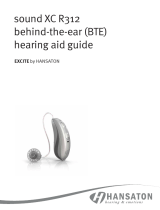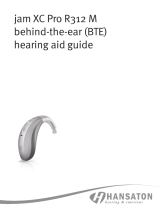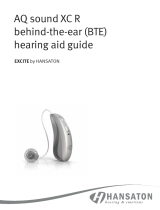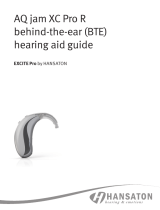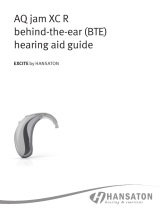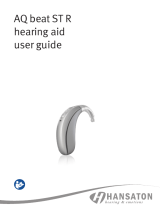
flow+
receiver-in-canal (RIC)
hearing aid guide

Thank you
Thank you for choosing these hearing aids.
This user guide applies to the following models:
Year of introduction:
Your hearing aids
Hearing care professional: ____________________
___________________________________________
Telephone: _________________________________
Model: ____________________________________
Serial number: ______________________________
Battery size: 312
Warranty: __________________________________
Program 1 is for: ____________________________
Program 2 is for: ____________________________
Program 3 is for: ____________________________
Program 4 is for: ____________________________
Date of purchase: ____________________________
flow+ S

Your hearing aids at a glance ..................................................... 2
Warnings .................................................................................... 4
Tinnitus masker ........................................................................ 11
Putting your hearing aids on your ears......................................14
Turning your hearingaids onando ....................................... 16
Battery information ...................................................................17
Operating instructions ............................................................. 20
Tinnitus masker ................................................................. 24
Wireless synchronization .................................................. 25
Using the telephone .......................................................... 25
Caring for your hearing aids .....................................................26
Assistive listening devices ....................................................... 30
Troubleshooting guide ..............................................................31
Warning to hearing aid dispensers (tocomplywith the
U.S. Food and Drug Administration (FDA) regulations) ........... 35
Information and explanation of symbols ................................. 37
Compliance information ...........................................................40
Your feedback .......................................................................... 42
Additional notes ....................................................................... 43
Table of contents
Quick reference
2 beeps every
30 minutes
Changing batteries Push button
switching programs
volume control
Battery indicator
OOn
Low battery warning Battery size
On/O
312

2 3
Your hearing aids at a glance
1 Wire - connects the speaker unit to your
hearingaids
2 Microphones - sound enters your hearing aids
through the microphones
3 Push button - switches between listening
programs or changes the volume level,
depending on your customized tting
4 Battery door (on & o) - close the door to turn on
your hearing aids, open the door all the way to
turn o your hearing aid or to change the battery
5 Dome - holds the speaker unit in place in your ear
canal
6 Retention piece - helps prevent the dome and
speaker unit from moving out of the ear canal
7 Speaker unit - amplies the sound and sends it
directly into the ear canal
8 Custom mold - holds the hearing aids in place
flow+ S hearing aids
2
2
3
4
5
1
6
7
2
2
3
4
8
1

4 5
Warnings
The intended use of hearing aids is to
amplify and transmit sound to the ears and
hereby compensate for impaired hearing.
The hearing aids (specially programmed for
each hearing loss) must only be used by the
intended person. They should not be used
by any other person as they could damage
hearing.
Hearing aids should only be used as
directed by your physician or hearing care
professional.
Hearing aids will not restore normal hearing
and will not prevent or improve a hearing
impairment resulting from organic conditions.
Do not use your hearing aids in explosion
hazard areas.
Allergic reactions to hearing aids are unlikely.
However, if you experience itching, redness,
soreness, inflammation or a burning
sensation in or around your ears, inform your
hearing care professional and contact your
physician.
In the unlikely case that any parts remain
in the ear canals aer the removal of
the hearing aids, contact a physician
immediately.
Special medical or dental examination
including radiation described below, may
adversely aect the correct functioning of
your hearing aids. Remove and keep them
outside the examination room/area before
undergoing:
- Medical or dental examination with X-ray
(also CT scan).
- Medical examinations with MRI/NMRI scans,
generating magnetic elds.
- Hearing aids don’t need to be removed
when passing security gates (airports etc.).
If X-ray is used at all, it will be in very low
doses, and will not aect the hearing aids.
Special care should be exercised in wearing
hearing aids when maximum sound pressure
levels exceed 132 decibels. There may be
a risk of impairing your remaining hearing.

6 7
Speak with your hearing care professional to
ensure the maximum output of your hearing
aids is suitable for your particular hearing
loss.
Battery warning
Never leave hearing aids or batteries
where small children and pets can reach
them. Never put hearing aids or batteries
in your mouth. If a hearing aid or battery is
swallowed, call a physician immediately.
Precautions
The use of hearing aids is only part of hearing
rehabilitation; auditory training and lip
reading instruction may be required as well.
In most cases, infrequent use of hearing aids
does not provide full benet. Once you have
become accustomed to your hearing aids,
wear your hearing aids everyday all day.
Your hearing aids use the most modern
components to provide the best possible
sound quality in every listening situation.
However, communication devices such as
digital mobile phones can create interference
(a buzzing sound) in hearing aids. If you
experience interference from a mobile phone
being used close by, you can minimize this
interference in a number of ways. Switch your
hearing aids to another program, turn your
head in a dierent direction or locate the
mobile phone and move away from it.
Protect hearing aids from heat (never
leave near a window or in the car). Never
use a microwave or other heating devices
to dry your hearing aids (due to risk of
re or explosion). Ask your hearing care
professional about suitable drying methods.
The dome should be changed every three
months or when it becomes sti or brittle.
This is to prevent the dome from detaching
from the tube spout during insertion into or
removal from the ear.
Do not drop your hearing aids. Dropping onto
a hard surface can damage your hearing aids.

8 9
Note to hearing care professional
Domes should never be tted on clients with
perforated eardrums, exposed middle ear
cavities, or surgically altered ear canals. In
the case of such a condition, we recommend
to use a customized earmold.
Labeling
The serial number and year of manufacture are
located under the colored hearing aid marking.
Mobile phone compatibility rating
Some hearing aid users have reported a
buzzing sound in their hearing aids when
they are using mobile phones, indicating
that the mobile phone and hearing aids may
not be compatible. According to the ANSI
C63.19 standard (ANSI C63.19-2011 American
National Standard Methods of Measurement
of Compatibility Between Wireless
Communications Devices and Hearing Aids), the
compatibility of particular hearing aids and a
mobile phone can be predicted by adding the
rating for the hearing aid immunity to the rating
for the mobile phone emissions. For example,
the sum of the hearing aid rating of 4 (M4) and
a telephone rating of 3 (M3) would result in a
combined rating of 7. Any combined rating that
equals at least 5 would provide “normal use”; a
combined rating of 6 or greater would indicate
“excellent performance.”
The immunity of these hearing aids is at leastM4.

10 11
The equipment performance measurements,
categories and system classications are based
upon the best information available but cannot
guarantee that all users will be satised.
The performance of the individual hearing
aids may vary with individual mobile phones.
Therefore, please try these hearing aids with
your mobile phone or, if you are purchasing a
new phone, please be sure to try it with your
hearing aids prior to purchase.
Tinnitus masker
Tinnitus masker uses broadband noise to
provide temporary relief of tinnitus.
Tinnitus masker warnings
The tinnitus masker is a broadband sound
generator. It provides a means of sound
enrichment therapy that can be used as
part of a personalized tinnitus management
program to provide temporary relief from
tinnitus.
The underlying principle of sound
enrichment is to provide supplementary
noise stimulation which can help defocus
your attention from your tinnitus and avoid
negative reactions. Sound enrichment,
coupled with instructional counseling, is an
established approach to managing tinnitus.
Air conduction hearing aids with the tinnitus
masker are to be tted by a hearing care
professional familiar with the diagnosis and
management of tinnitus.

12 13
Should you develop any side eects
while using the tinnitus masker, such as
headaches, nausea, dizziness or heart
palpitations or experience a decrease
in auditory function such as decreased
loudness tolerance, worsening of tinnitus, or
speech not as clear, you should discontinue
use of the device and seek medical
attention.
The volume of the tinnitus masker can be
set to a level which could lead to permanent
hearing damage when used for a prolonged
period of time. Should the tinnitus masker
be set to such a level in your hearing aids,
your hearing care professional will advise
you of the maximum amount of time per
day you should use the tinnitus masker. The
tinnitus masker should never be used at
uncomfortable levels.
Important information
The tinnitus masker generates sounds that are
used as part of your personalized temporary
tinnitus management program to provide relief
from tinnitus. It should always be used as
prescribed by a hearing care professional who
is familiar with the diagnosis and treatment of
tinnitus.
Good health practice requires that a person
reporting tinnitus have a medical evaluation by
a licensed ear physician before using a sound
generator. The purpose of such an evaluation
is to ensure that medically treatable conditions,
which may be causing tinnitus, are identied
and treated prior to using a sound generator.
The tinnitus masker is intended for adults 18
years of age or older who have both hearing
loss and tinnitus.

14 15
Putting your hearing aids on your ears
Your hearing aids may be color-coded with an
indicator on the battery door: red = right ear;
blue = le ear.
Hearing aids with domes
1. Place the hearing aid over
the top of your ear.
2. Hold the wire where it
attaches to the dome and
gently push the dome into
your ear canal. The wire
should lie flush against
your head and not stick out.
3. If there is a retention piece,
place it in your ear so it
rests at the bottom of the
opening of your ear canal.
2.
3.
1.
Hearing aids with custom molds
1. Hold the custom mold
between your thumb and
index nger. The opening
should be pointing in
towards your ear canal with
the hearing aid resting
above your ear.
2. Carefully insert the custom
mold into your ear. The
mold should t into your
ear snugly and comfortably.
3. Place the hearing aid over
the top of your ear.
1.
2.
3.

16 17
Turning your hearingaids onando
The battery door acts as an on and o switch.
1. On: Close the battery door
fully.
It may take ve seconds before
the hearing aids turn on. Your
hearing care professional can
increase the start up delay if
required.
2. O: Open the battery door.
When turning your hearing aids
on and o while they are on the
ear, grasp the top and bottom
of the device with your index
nger and thumb. Use the
index nger of your opposite
hand to open and close the
battery door.
1.
2.
Battery information
Low battery warning
Two long beeps indicate the hearing aid battery
is low. Aer the low battery warning, sounds
may not be as clear. This is normal and can be
xed by changing the batteries.
If you can’t hear the low battery warning, your
hearing care professional can change its pitch
or loudness. If you prefer, it can be turned o
entirely.
Your hearing aids are designed to generate a
low battery warning every 30 minutes until you
change the batteries, but depending on the
condition of the batteries, they may die before
another low battery warning occurs. Therefore, it
is recommended that the batteries are replaced
as soon as possible once you hear the low
battery warning.

18 19
Replacing the battery
1. Gently swing out the battery
door with your ngernail.
2. Push the battery with your
ngernail towards the open
side, and remove.
3. Insert the new battery into the
battery compartment with the
plus (+) sign on the battery
facing the same way as the
battery indicator on the battery
door. This will ensure that the
battery door closes properly.
If the battery is inserted
incorrectly, the hearing aids will
not turn on.
4. Close the battery door.
1.
2.
3.
4.
Caring for batteries
• Always discard batteries in a safe and
environmentally friendly way.
• To prolong battery life, remember to turn your
hearing aids o when not in use, especially
when asleep.
• Remove the batteries and keep the battery
door open while hearing aids are not being
worn, especially when asleep. This will allow
internal moisture to evaporate.

20 21
Operating instructions
Your hearing aids come with a push button that
may allow you to further adjust them.
Push button
The push button on your hearing aids
can be either a program control, a
volume control or a combination of both.
Program control
If your push button is a program control, each
time you push the button, you will move to a
new hearing aid program.
Your hearing aids beep to indicate which
program you are in.
Program setting Beeps
Program 1 (e.g. AutoMic) 1 beep
Program 2 (e.g. speech in noise) 2 beeps
Program 3 (e.g. telephone) 3 beeps
Program 4 (e.g. music) 4 beeps
Wireless synchronization
(if enabled)
Opposite ear beeps
the same as side
being adjusted
Please see the front of this booklet for a listing
of your personalized programs.

22 23
Volume control
If your push button has been congured as a
volume control, either:
• Push the button on your right hearing aid to
increase the volume, and
• Push the button on your le hearing aid to
decrease the volume
or:
• Push the button to step through your volume
levels
As you change the volume control, your hearing
aids will beep.
Volume setting Beeps
Suggested volume level 1 beep
Turning volume up short beep
Turning volume down short beep
Maximum volume level 2 beeps
Minimum volume level 2 beeps
Program/volume control push button
If your hearing care professional has congured
one hearing aid to be a program control and the
other hearing aid to be a volume control:
• Push the button on your right / le
hearing aid to access your dierent programs,
and
• Push the button on your right / le
hearing aid to step through your volume levels

24 25
Tinnitus masker
If your hearing care professional has congured
both a tinnitus masker program and a volume
control, you can adjust the tinnitus masker level
while you are in the tinnitus masker program. To
adjust the noise level, either:
Push button (right/le)
• Push the button on your right hearing aid to
increase the tinnitus masker, and
• Push the button on your le hearing aid to
decrease the tinnitus masker
Push button (steps)
• Push the button to step through your tinnitus
masker volume levels
As you change the level, your hearing aids will
beep.
Wireless synchronization
If wireless synchronization is enabled, when you
change the volume or program settings on one
hearing aid, the other one changes as well.
For example, if your push button is congured as
a program control and wireless synchronization
is enabled, when you push the button on one
hearing aid, the program will change on both
hearing aids.
Using the telephone
Your hearing care professional may have set up
a phone program on your hearing aids that you
can access using the push button.

26 27
Caring for your hearing aids
Protecting your hearing aids
• Open the battery doors when not in use.
• Always remove your hearing aids when
using hair care products. The hearing aids
can become clogged and cease to function
properly.
• Do not wear your hearing aids in the bath or
shower or immerse them in water.
• If your hearing aids do become wet, do not
attempt to dry them in an oven or microwave.
Do not adjust any controls. Open the battery
doors immediately, remove the batteries and
allow your hearing aids to dry naturally for
24hours.
• Protect your hearing aids from excessive heat
(hair dryer, vehicle glove box or dashboard).
• Ensure you do not twist or squeeze the wires
when your hearing aids are placed in their
case.
• Regular use of a dehumidier, such as a
Clean Dry kit, can help prevent corrosion and
prolong the life of your hearing aids. Remove
batteries before using a dehumidier.
• Do not drop your hearing aids or knock them
against hard surfaces.

28 29
Cleaning your hearing aids
Use a so cloth to clean your hearing aids at
the end of each day. Regular cleaning of the
microphone ports with the supplied cleaning
brush will ensure that your hearing aids will
maintain their sound quality. Your hearing care
professional can demonstrate this for you.
Place the hearing aids in the case overnight
with the battery doors open to allow moisture
to evaporate.
Ear wax is natural and common. Ensuring your
hearing aids are free of ear wax is an important
step in your daily cleaning and maintenance
routine.
Never use alcohol to clean your hearing aids,
earmolds or domes.
Do not use sharp tools to dislodge ear wax.
Sticking household items into your hearing aids
or custom molds can seriously damage them.
Cleaning your custom molds and domes
Clean the domes and molds on the
outside daily with a damp cloth.
Avoid getting any water in and around
the speaker units and custom molds.
The wires, speakers, domes or custom molds
should never be rinsed or submerged in water
as water drops may block sound or damage the
electrical components of the hearing aids.
Domes should be replaced every -6 months or
when they become sti, brittle, or discolored.
If your molds require further cleaning, the
speaker waxguard may be plugged and require
replacing. See your hearing care professional.

30 31
Assistive listening devices
Listening in public places
Telecoils pick up electromagnetic energy and
convert it into sound. Your hearing aids may
have a telecoil option that can help you listen in
public places equipped with telecoil compatible
assistive listening devices such as a loop
system. When you see this symbol, a
loop system is present and may be
compatible with your hearing aids.
Please contact your hearing care professional for
more information on loop systems.
Cause Possible remedy
Issue: no sound
Not turned on Turn on
Low/dead battery Replace battery
Poor battery contact Consult your hearing care
professional
Battery upside down Insert battery according
to battery symbol inside
battery door
Custom molds/domes
blocked with ear wax
Clean custom molds/domes.
See “Cleaning your hearing
aids.” Consult your hearing
care professional
Plugged microphones Consult your hearing care
professional
Troubleshooting guide

32 33
Cause Possible remedy
Issue: not loud enough
Low volume Turn up volume; see hearing
care professional if problem
persists
Low battery Replace battery
Custom molds/domes
not inserted properly
See “Putting your hearing
aids on your ears.” Remove
and reinsert carefully
Change in hearing Consult your hearing care
professional
Custom molds/domes
blocked with ear wax
Clean custom molds/domes.
See “Cleaning your hearing
aids.” Consult your hearing
care professional
Plugged microphones Consult your hearing care
professional
Issue: intermittent sound
Low battery Replace battery
Dirty battery contact Consult your hearing care
professional
Cause Possible remedy
Issue: two long beeps
Low battery Replace battery
Issue: whistling
Custom molds/domes
not inserted properly
See “Putting your hearing
aids on your ears.” Remove
and reinsert carefully
Hand/clothing near ear Move hand/clothing away
from ear
Poorly tting custom
molds/domes
Consult your hearing care
professional
Issue: not clear, distorted
Poorly tting custom
molds/domes
Consult your hearing care
professional
Custom molds/domes
blocked with ear wax
Clean custom molds/domes.
See “Cleaning your hearing
aids.” Consult your hearing
care professional
Low battery Replace battery
Plugged microphones Consult your hearing care
professional

34 35
Cause Possible remedy
Issue: custom molds/domes falling out of ear
Poorly tting custom
molds/domes
Consult your hearing care
professional
Custom molds/domes
not inserted properly
See “Putting your hearing
aids on your ears.” Remove
and reinsert carefully
Issue: low volume on landline telephone
Telephone not
positioned properly
Move telephone receiver
around ear for clearer signal
Hearing aids require
adjustment
Consult your hearing care
professional
For any problems not listed in the guide, contact your
hearing care professional.
Warning to hearing aid dispensers
(tocomplywith the U.S. Food and Drug
Administration (FDA) regulations)
A hearing aid dispenser should advise a prospective hearing aid
user to consult promptly with a licensed physician (preferably
an ear specialist) before dispensing a hearing aid if the hearing
aid dispenser determines through inquiry, actual observation,
or review of any other available information concerning the
prospective user, that the prospective user has any of the
following conditions: (i) Visible congenital or traumatic deformity
of the ear. (ii) History of active drainage from the ear within the
previous 90 days. (iii) History of sudden or rapidly progressive
hearing loss within the previous 90 days. (iv) Acute or chronic
dizziness. (v) Unilateral hearing loss of sudden or recent onset
within the previous 90 days. (vi) Audiometric air-bone gap
equal to or greater than 15 decibels at 500 hertz (Hz), 1,000
Hz, and 2,000 Hz. (vii) Visible evidence of signicant cerumen
accumulation or a foreign body in the ear canal. (viii) Pain or
discomfort in the ear.
Important notice for prospective hearing aid users
Good health practice requires that a person with a hearing loss
have a medical evaluation by a licensed physician (preferably
a physician who specializes in diseases of the ear) before
purchasing a hearing aid.
Licensed physicians who specialize in diseases of the ear
are oen referred to as otolaryngologists, otologists or
otorhinolaryngologists. The purpose of medical evaluation is to
assure that all medically treatable conditions that may aect hearing
are identied and treated before the hearing aid is purchased.
Page is loading ...
Page is loading ...
Page is loading ...
Page is loading ...
Page is loading ...
Page is loading ...
Page is loading ...
/

